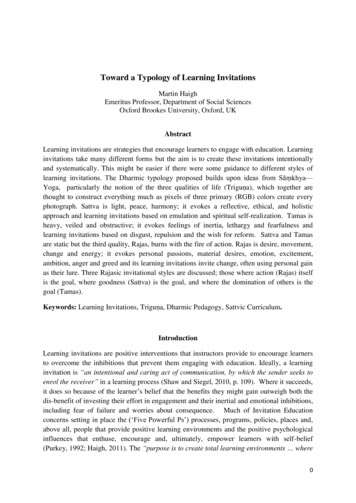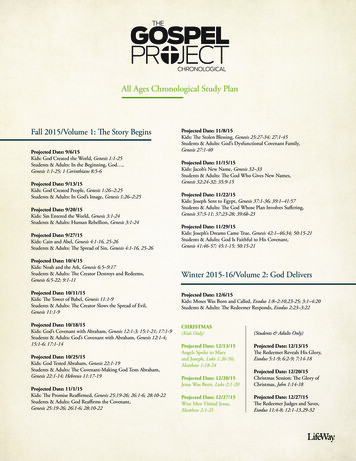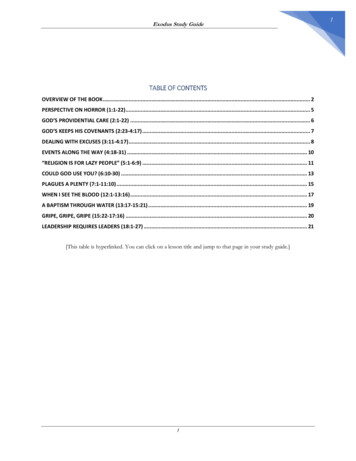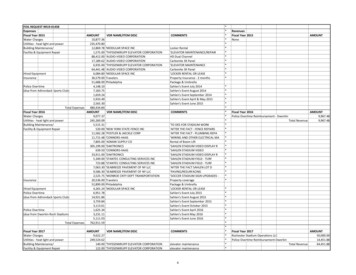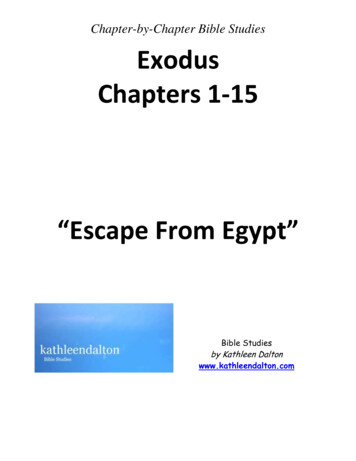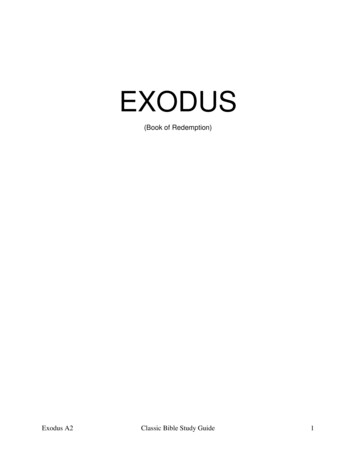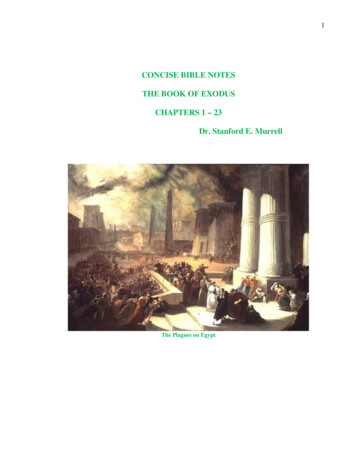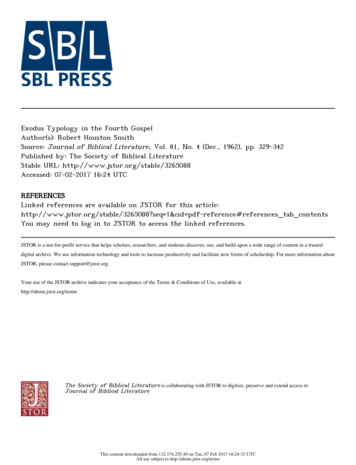
Transcription
Exodus Typology in the Fourth GospelAuthor(s): Robert Houston SmithSource: Journal of Biblical Literature, Vol. 81, No. 4 (Dec., 1962), pp. 329-342Published by: The Society of Biblical LiteratureStable URL: http://www.jstor.org/stable/3265088Accessed: 07-02-2017 16:24 UTCREFERENCESLinked references are available on JSTOR for this article:http://www.jstor.org/stable/3265088?seq 1&cid pdf-reference#references tab contentsYou may need to log in to JSTOR to access the linked references.JSTOR is a not-for-profit service that helps scholars, researchers, and students discover, use, and build upon a wide range of content in a trusteddigital archive. We use information technology and tools to increase productivity and facilitate new forms of scholarship. For more information aboutJSTOR, please contact support@jstor.org.Your use of the JSTOR archive indicates your acceptance of the Terms & Conditions of Use, available athttp://about.jstor.org/termsThe Society of Biblical Literature is collaborating with JSTOR to digitize, preserve and extend access toJournal of Biblical LiteratureThis content downloaded from 132.174.255.49 on Tue, 07 Feb 2017 16:24:32 UTCAll use subject to http://about.jstor.org/terms
EXODUS TYPOLOGY IN THE FOURTHGOSPELROBERT HOUSTON SMITHTHE COLLEGE OF WOOSTERIN THE continuing search for the origins and structuralunderlying the Gospel of John, one of the most promising sinsight would seem to be that of exodus typology, which iattested in many other NT writings but finds specific expresstimes in John. Yet the results of recent investigations in thishave been only partially successful, as a survey of several sreveal.In his article "The Book of Exodus as a Literary Type for the Gospelof John,"' Jacob J. Enz sets forth the hypothesis that the Fourth Gospelnot only has many isolated instances of typology related to the exodustraditions but also shows a running parallelism of content to the book ofExodus. As evidence for the latter he cites the following similarities:Both documents make early reference to the unrecognized deliverer(Exod 2 11 ff. John 1 11); the sign of the serpent is also referred to earlyin both writings (Exod 4 4 f. John 3 14 f.); both writings reveal a responseof belief to the first signs (Exod 4 30 John 2 11); the early sections ofboth books are built deliberately around a series of signs (Exod 3 1213 16 John 2 11-12 37); the latter part of both books is concerned withthe Lord's own people (Exod 16-40 John 13-21) and with such otherthings as the construction of the sanctuary (Exod 25-31, 35-40 John19 30), divine commandments (Exod 20-23 John 13 34), prayers ofintercession (Exod 32-33 John 17), and the credentials of the leader(Exod 33 16 John 17 5); the manner of closing is similar (Exod 40 33b John 19 30); and finally, the effect of the signs upon the people can becompared (Exod 14 31; 19 9; 35-40 passim John 12 37-42; 20 8, 25, 30 f.).B. P. W. Stather Hunt2 finds quite a different exodus typology withinthe Fourth Gospel. Noting a "Jewish tradition" which said that whenthe Messiah came he would duplicate, on a higher plane, the miracleswhich Moses had done in the wilderness, Hunt proceeds to identify whathe considers to be Moses' chief miracles in the wilderness and to correlatewith them certain Johannine materials (chiefly miracles), with theJBL, 76 (1957), pp. 208-15.2 Some Johannine Problems.? 1962, by The Society of Biblical Literature and ExegesisThis content downloaded from 132.174.255.49 on Tue, 07 Feb 2017 16:24:32 UTCAll use subject to http://about.jstor.org/terms
330JOURNAL OF BIBLICAL LITERATUREfollowing results: the sweetening of the waters of Marah (Exod 15 23-26) the wedding at Cana (John 2 1-11); the feeding of Israel with manna(Exod 16 11-36) the feeding of the five thousand (John 6 1-14); theprovision of water in the desert (Num 20 7-13) Jesus' conversation withthe Samaritan woman at the well, and Jesus' later claim to be the livingwater (John 4 7-42; 7 37-38); the healing of the Israelites with the bronzeserpent (Num 21 8-9) Jesus' healing by his death on the cross (John 19).Yet another scheme is proposed by Harald Sahlin in his monographZur Typologie des Johannesevangeliums.3 Sahlin alleges that the FourthGospel is constructed on an OT typology which extends from the earlychapters of Exodus through I Kings 8. Some of the more importantcomparisons which he draws are: the call of Moses (Exod 3-4) thebeginning of the gospel (John 1); Moses' turning of the Nile into blood(Exod 7 14-24) the wedding at Cana (John 2 1-11); the saving of thechildren of Israel at the Red Sea (Exod 14 19-15 21) Jesus' conversationwith Nicodemus (John 3 1-21); the camping of the Israelites at Elim(Exod 15 27) Jesus and the Samaritan woman (John 4 4-42); the words,"I, the Lord, am your healer" (Exod 15 26) the healing of the official'sson and the healing of the lame man (John 4 46-54; 5 1 ff.); the manna inthe wilderness (Exod 16) the feeding of the multitude (John 6 1-14);the Lord's appearance in a cloud (Exod 16 6-12) Jesus' walking on the sea(John 6 16-21); the complaint of the children of Israel (Exod 17 2-4) the Jews' rejection of Jesus' mission and baptism and authority (John7 1-36); God's provision of water from the rock (Exod 17 5-7) Jesus'offer of living water (John 7 37-44); the story of the golden calf (Exod32) the story of the woman taken in adultery (John 7 53-8 11); the bookof Leviticus Jesus' healing of the blind man (John 9); the appointmentof Joshua as Moses' successor (Num 27 16-23) Jesus as the good shepherd(John 10); Joshua's deeds (Josh 1-5) Jesus' raising of Lazarus (John 11);Solomon's riding to Gihon and being anointed king (I Kings 1 32-40) the anointing of Jesus and the entry into Jerusalem (John 12 1-19); Solo-mon's dedication of the temple (I Kings 8) Jesus and his disciples atsupper, Jesus' high priestly prayer, Jesus' passion (John 13; 17; 18-19);no parallels for Jesus' resurrection and the conclusion of the gospel.Still other theories of exodus typology in the Fourth Gospel could bebrought forward, but these three illustrate well the present state ofresearch. The difficulty is not that there are too few theories but thatthere are too many. Even allowing for the fact that Johannine imageryis often subtle and complex, it hardly seems possible that all of thesecompeting hypotheses can be equally correct. Clearly some evaluationis in order. This can best be accomplished by observing the extent towhich the theories meet four basic requirements.3 1950.This content downloaded from 132.174.255.49 on Tue, 07 Feb 2017 16:24:32 UTCAll use subject to http://about.jstor.org/terms
SMITH: EXODUS TYPOLOGY IN THE FOURTH GOSPEL3311. A typological analysis should sensitively reflect ttypology can take many forms and serve varied functionsassume that every typological allusion is necessarily integrscheme, though of course it may be. Some typologies are strhaving their validity solely in the correlation of a single Osome aspect of the Christian tradition, without particucontext. Typologies which occupy a genuinely structuraliterature must consist of some fundamental correlation such as those ofMoses Jesus and Israel Church, ideas which arise not from the similarity of isolated details in the OT and Christian traditions but rather fromthe perception of profounder similarities between complexes of majorevents in the respective traditions.This principle is quite important in the typological analysis of theFourth Gospel. The Johannine identification of Jesus as the serpentwhich Moses lifted up in the wilderness (John 3 14 f.) is a clear instanceof terminal typology (the lifting up of the healing serpent the liftingup of the healing savior). When Hunt brings this passage into his schemeof Jesus' repetition of Moses' wilderness miracles, he does so only byunconsciously inverting the typology, treating Jesus as the miracleworker Moses rather than as the serpent. The Johannine passage itself iscontent with the terminal correlation of Jesus serpent. A similarobservation can be made about the reference to Jesus as the manna(John 6), which both Hunt and Sahlin work into their typologies. Whileboth of these passages in the Fourth Gospel reflect the interest of theevangelist in the application of exodus traditions to Jesus, neither ofthem can be said to occupy a typologically structural role in the gospel.2. A convincing typological hypothesis will rely primarily on a correlation between materials which are similar in form. One can comparewords with words, stories with stories, and ideas with ideas much morereasonably than, say, words with whole stories and narrative details withconcepts. This principle must be laid down even though there areinstances where NT writers did derive typologies from unlike materials,and even though it is sometimes debatable as to just what constitutestrue similarity of form.Evaluated by this criterion, Hunt's presentation stands up ratherwell, for it consists chiefly of a comparison of miracles with miracles. Enzmakes some apt comparisons, but founders on others; perhaps the moststriking instance of the latter is his citation of Jesus' words on the cross,"It is finished," as a parallel for the whole thirteen chapters of Exoduswhich deal with the tabernacle.4 Sahlin is especially given to the com4 Enz also draws attention to Jesus' reference to rebuilding the temple in threedays (John 2 18-21), but this passage is also a very inadequate parallel for the chaptersin Exodus which deal with the tabernacle.This content downloaded from 132.174.255.49 on Tue, 07 Feb 2017 16:24:32 UTCAll use subject to http://about.jstor.org/terms
332JOURNAL OF BIBLICAL LITERATUREparison of unlike items, with the result that much of his analysis isliable to strike one as fanciful. He takes, for example, the statement,"Then they came to Elim, where there were twelve springs of water andseventy palm trees; and they encamped there by the water" (Exod 15 27),which is really only a bit of narrative framework without any accompanying traditions, as a parallel for the account of Jesus' encounter withthe Samaritan woman, which is a lengthy story-discourse of quite adifferent nature. Similarly implausible because of the inequality ofmaterials is his paralleling of the whole of Leviticus with the story ofJesus' healing of the blind man.3. Any theory of an extended typology - that is, one covering considerable portions of a NT work and occupying a structural r61e in itmust account satisfactorily for all of the materials in the units which arebeing compared, either by putting everything into parallel or by reasonably justifying the omission of any sizable amount of material whichdoes not fit the scheme. This, of course, is only a specialized form of thescholarly principle that one must make every effort not to be arbitraryin selecting one's evidence.Both Enz and Sahlin, with their theories of typology which extendsthroughout the Gospel of John, fail to meet this requirement, for theyleave portions of both the gospel and the OT parallels (particularly thelatter) unaccounted for. Because he extends his OT parallels to theFourth Gospel over a large area, Sahlin is particularly open to criticism.He makes no explanation, for example, of why the fourth evangelistskipped from Num 27 to Josh 1-5 and then to I Kings 1 and 8 for histypology. This is a serious weakness, for, after all, if one has a largebody of varied materials with which to work, one can devise a theory ofalmost any kind. Hunt, though he also chooses widely scattered materialsfor his typology, is relatively safe from criticism, since he limits histypology to one of the wilderness miracles only; nevertheless, he exercisessome arbitrariness in selecting only the four wilderness miracles whichhe does, and he fails to explain the existence of those Johannine miracleswhich have no parallels in the wilderness traditions. Thus in varyingdegrees all of these scholars present theories which involve the arbitraryselection of evidence.4. A typological scheme must be compatable with the theology ofthe work in which it is used; indeed, if the typology is extensive andfundamental, it may be expected to contribute to the argument of thework. This principle, which arises from the general fact that the OTserves an important theological function in NT literature, is perhaps themost neglected of all in typological research.With regard to this principle all of the works which we have beendiscussing are deficient. Enz and Sahlin, preoccupied with details, donot take up the question at all; if they were to do so, they might have someThis content downloaded from 132.174.255.49 on Tue, 07 Feb 2017 16:24:32 UTCAll use subject to http://about.jstor.org/terms
SMITH: EXODUS TYPOLOGY IN THE FOURTH GOSPEL333second thoughts about the typologies they propose. Exodubooks which continue the story of the Hebrews' wanderings ament presuppose a progressive revelation of God in historygenerally recognized, the fourth evangelist has no sympathy widea of progressive historical revelation, holding instead thtwo contrasting eras, the old and the new.5 Why would he havtured his gospel along lines which were essentially foreign towise, the period of the wanderings is highlighted by the Sinai ewith its emphasis upon God's giving of the law to Moses, the cbetween God and Israel, and the establishment of the Hebryet aside from an occasional reference to the law of Moses as afact, the fourth evangelist shows little concern with these matpresumably feels that he has shown the validity of his wildernesby simply pointing to the belief that the Messiah would duplimiracles in the desert; but he does not show why this particulamong the many current in the first century, was singled ouevangelist for special attention.In view of their general failure to meet these basic requiremmust conclude that the proposals of Enz, Hunt, and Sahlin areconvincing. Some of the objections which we have raised couldated by a restatement of the arguments, but other difficulremain. Thus we are left with no plausible theory of exoduunderlying the Fourth Gospel - unless we can advance an alterour own.IIThe most likely place where one may seek an exodus typologmajor proportions in the Gospel of John is not the traditions concerthe Hebrews after they departed from Egypt but in those concernithem before their departure and up to it, i. e., the materials of2 23-12 51. In amplifying and testing this hypothesis we may beginthe dominant feature of this unit of material, the signs which Mperforms in Egypt.Exod 2 23-12 51 is built around the theme of belief in the self-revedeity. The crucial issue of Moses' call is YHWH's revelation of his naand his sovereignty. Anticipating disbelief among the IsraelitesEgyptians, YHWH arranges to prove his existence and his migh5 See Otto A. Piper, "Unchanging Promises: Exodus in the New Testament," Inpretation, 11 (1957), pp. 3-22; note especially the statement that "John has no roodivinely guided history. It is the contrast between old and new, appearanctruth, which dominates John's thinking. While the evangelist is far from denyinhistoricity of the events, they do not, as in Paul's case, form the foundation of a pfrom which the new covenant emerges" (p. 5).This content downloaded from 132.174.255.49 on Tue, 07 Feb 2017 16:24:32 UTCAll use subject to http://about.jstor.org/terms
334JOURNAL OF BIBLICAL LITERATUREinvesting Moses with the power to perform "signs and wonders"-Hebrew, 'nsiln nmnlt; LXX, arue'ta Kal rzpara - or, as they are oftencalled, simply "signs" (see Exod 3 12; 4 8-9; 7 3; 8 23; 10 1-2). Although"signs and wonders" cannot be regarded as "technical terminology,"it is interesting to note that when the phrase is used elsewhere in the OTit almost always refers to Moses' miraculous deeds, either as they wereoriginally performed (e. g., Deut 4 34; Ps 78 43-51) or as God will performthem in an eschatological repetition of the exodus experience (e. g.,Dan 4 2 f.; cf. IV Ezra 7 26 f.).6 Thus when we find the expression r7j/eiaKal repara (or simply (ynela) occurring in the Fourth Gospel in connection with specific miracles (John 2 11; 4 48, 54; 6 14; 9 16; 11 47) as wellas by way of general reference (e. g., John 2 23; 6 2), it is evident that thetradition of Moses' signs and wonders lies in the background.7That the fourth evangelist saw Jesus' signs as antitypes of Moses'signs is indicated by several other points of similarity. In the gospel,as in the Exodus materials, the aim of the miracles is to bring the recipient or observer to a recognition of the power of the deity. The gospellikewise portrays Jesus as reluctant to perform signs - note the distasteimplied in Jesus' words, "Unless you see signs and wonders you will notbelieve!" (John 4 48)- even as YHWH seems reluctant to loose hisafflictions upon Egypt. Finally, the reaction of "the Jews" to Jesus'signs is one of disbelief, an attitude which is reminiscent of the "hardnessof heart" of Pharaoh.8We now come to the Johannine signs individually, which are sosimilar to the Mosaic signs that it seems that the fourth evangelist hasdeliberately arranged them as parallels.The first Mosaic sign is that of turning water into blood (Exod 7 14-24).With it one may justifiably compare Jesus' miraculous changing of waterinto wine at Cana (John 2 1-11).9 Jesus, like Moses,1? has divine power,6 See S. V. McCasland, "Signs and Wonders," JBL, 76 (1957), pp. 149-52; F.-M.Braun, "L'lvangile de saint Jean et les grandes traditions d'Israel, IV: Moise et l'exode,"Revue Thomiste, 68 (1960), pp. 165-84, especially p. 179.7 In his brief comments on the signs, Enz advances the suggestion that the Mosaicsign group constitutes a parallel to the Johannine sign group (op. cit., p. 210). It isregrettable that he does not pursue the matter more deeply, for he is clearly on theright track.8 Contrast the belief of Jesus' disciples, who correspond to the Israelites who believewhen they see YHWH's signs; cf. John 2 11, etc. The parallelism between Pharaoh'shardening of his heart and the disbelief of the Jews is noted by Braun, op. cit., pp. 174 f.;cf. also Enz's comment, op. cit., p. 210. We shall return to these points of similaritylater.9 Sahlin, op. cit., pp. 8 ff., recognizes a parallelism between the first Johannine signand the first Mosaic sign. For parallels to the second and subsequent Johannine signs,however, he turns to the latter part of Exodus and to other books.10 Jesus is obviously the antitype of Moses, yet throughout the Johannine signs heThis content downloaded from 132.174.255.49 on Tue, 07 Feb 2017 16:24:32 UTCAll use subject to http://about.jstor.org/terms
SMITH: EXODUS TYPOLOGY IN THE FOURTH GOSPEL335with which he changes water into wine, the "blood of the graif the fourth evangelist has Moses' first sign in mind here, at the she significantly inverts its nature. Instead of creating deablood, Jesus creates life-giving wine.12 Thus we find here the frence of the concept, to be found submerged in the other Johanas well, that whereas Moses demonstrated divine power bydestruction, Jesus demonstrates that same power by benefiThe Mosaic deed thus serves as the type of Jesus' deed inwhich conforms to the typology of Paul and, in part, to thwriter of the Epistle to the Hebrews. What was performeHebrew figures in the past was imperfect, and is now recapituJesus in a perfect way.The second, third, and fourth signs of Moses, the successive oof frogs, gnats, and flies (Exod 7 25-8 32), which are fairly simithey constitute a proliferation of troublesome but presumablypests, seem to have no parallels in the Fourth Gospel. This iticularly disturbing, for if, as we shall see, the writer seemwished to show Jesus performing only seven signs rather thanten, he obviously had to leave out some of the material in Exomodern reader will probably concur in the fourth evangelist'sthat these three episodes were most expendable, for two of theof the gnats and the flies - are especially colorless.The fifth of Moses' signs, that of the bringing of a plaguedomestic animals of Egypt (Exod 9 1-7), also has no obvious Joparallel, but in this instance one is perhaps justified in suggestthe fourth evangelist intended it to be paralleled by the storyhealing of the official's son (John 446-54). In both signs the afleads to death. There is also an element of indirectness in thefor the Egyptians are not afflicted in their own bodies and thhimself is not ill.I4 We see here the same typological inversionalso comes near to functioning as an antitype of YHWH himself. The conffrom the presence of the two figures in the Exodus accounts." This idiom appears both in the OT (e. g., Deut 32 14) and in the intertliterature (e. g., I Macc 6 34).2 The Jewish and early Christian symbolical interpretation of wine as afluid is explored in detail in E. R. Goodenough, Jewish Symbols in the GrPeriod, v and VI. The story of the wedding at Cana presumably did norevolve around the motif of Jesus' life-giving blood, but that association cangone unnoticed by the users of the tradition.'3 See Piper, op. cit., p. 20.'4 The Johannine story would parallel the account in Exodus more closelynot the official's son who was ill but his slave - a piece of valuable livinInterestingly enough, in Luke's version of the parallel Q story (Luke 7 1-10o)(bovXos) who is ill. Matthew's version (Matt 8 5-13) reads 7ra?s, whicheither "son" or "slave."This content downloaded from 132.174.255.49 on Tue, 07 Feb 2017 16:24:32 UTCAll use subject to http://about.jstor.org/terms
336JOURNAL OF BIBLICAL LITERATUREnoted in connection with the first Johannine sign: whereas Moses bringsabout the extinction of valued possessions, Jesus sustains life in thatwhich is treasured. Of all of the comparisons which we shall draw, thisis the weakest; but though the points of similarity are not strong, neitherare they perhaps entirely without value.The sixth sign in Exodus is the affliction of the Egyptians with adisease which produces sores on the body (Exod 9 8-12). This is the firstoccasion in the Exodus narrative in which real bodily affliction occurs.With it we may compare the story of Jesus' healing of the lame man atthe pool of Bethesda (John 5 2-9), which is the first of Jesus' signs inwhich direct personal affliction is involved.I5 The type and antitype arefairly clear; in the one, Moses brings physical debilitation, while in theother, Jesus brings restoration to health.The seventh sign of Moses is that of the summoning of a thunderstorm upon Egypt, which brings with it devastating hail (Exod 9 13-35).For the Johannine parallel we must break, for the first and only time, theorder between the two sets of materials, and find the matching accountto be that of Jesus' stilling of the storm on the Sea of Galilee (John6 16-21). This story, which combines the idea of Jesus' stilling of thestorm with that of his walking on the sea,'6 shows the usual pattern:whereas Moses conjures up a storm to bring destruction, Jesus, byimplication, stills a storm and brings calm.The eighth sign in Exodus, that of the attack by locusts upon thefoliage and fruit of Egypt, which leaves the people without agriculturalsustenance (Exod 10 1-20), has a fairly obvious parallel in the Johannineaccount of Jesus' feeding of the multitude with bread (John 6 1-15).17The Exodus type describes Moses' bringing of famine to those who havefood; the Johannine antitype emphasizes Jesus' supplying of an abundance of food to those who are hungry.The ninth sign which Moses performs is that of invoking darknessupon Egypt (Exod 10 21-29). With its specific statement that the dark-ness was so deep that the people behaved as though blind, the ExodusI5 It is possible that the Johannine writer was attracted to this particular healingstory because at one point it bears a detailed, if incidental, resemblance to the Exodusaccount. In the healing at Bethesda the lame man is so afflicted that he is unable torise in order to get into the pool; in the Mosaic affliction the Egyptian magicians are soill that they cannot stand before Moses.16 The same motifs are brought together in the account in Mark 6 45-52 and parallel,but only the element of the stilling of the storm appears in the story in Mark 4 35-41and parallels. In those accounts which combine the two motifs, that of the stilling ofthe storm becomes secondary to that of the walking on the sea.'7 Not only in the Johannine story of the feeding but in the Synoptic accounts aswell (the five thousand, Mark 6 30-44 and parallels; and the four thousand, Mark 8 1-10and parallel) the bread occupies the central place and the fish is mentioned almost as anafterthought.This content downloaded from 132.174.255.49 on Tue, 07 Feb 2017 16:24:32 UTCAll use subject to http://about.jstor.org/terms
SMITH: EXODUS TYPOLOGY IN THE FOURTH GOSPEL337account offers a solid type for the Johannine account of tthe blind man (John 9 1-41), in which Jesus brings sight toin darkness.'8The tenth sign in the Exodus account is the slaughter of the firstborn of Egypt within a night (Exod 11 1-12 32). It serves as an effectiveclimax to the series of signs, and has its obvious parallel in the story ofthe raising of Lazarus (John 11 1-44), which seems rather clearly to beintended as the culmination of Jesus' miraculous deeds. Death is thedominant thought in both stories, but in the former God brings deathwhere there was life, whereas in the latter Jesus brings life where therewas death.With the story of the raising of Lazarus we should, so far as thethought of the Fourth Gospel is concerned, also link the tradition ofJesus' own resurrection, which the writer of the gospel apparently considered to be a sign (see John 20 30; 13 19; 2 18-22). In the resurrectionGod performs for Jesus what earlier Jesus has done for Lazarus,I9 thusrevealing himself to be not, as the Exodus story assumes, one whoallows the death of the first-born to be final but one who raises up thefirst-born (Jesus) to life.20 That the death-resurrection of Jesus shouldbe understood as linked with the final Mosaic sign is further indicated bythe presence of the paschal lamb typology.2" Thus, as the Fourth Gospeli8 In the discussion between Jesus and the Jews which follows the healing, we findan echo of the motif of affliction which characterizes the Mosaic signs. Jesus says, "Forjudgment I came into this world, that those who do not see may see, and that those who;see may become blind" (John 9 39). Just as Moses' signs bring salvation to the Israelitesand destruction to the Egyptians, so do Jesus' signs bring salvation to those who believe,and destruction to the Jews. In general, however, the destructive power of Jesus' signsis not emphasized in the Fourth Gospel.I9 It is not surprising that the Lazarus story stands near the passion narrative, forsome of its features show that it participates in traditions clustered around Jesus',crucifixion and resurrection. Matt 27 52-53 mentions the tradition that at Jesus' deathtombs opened and many bodies of the saints were resurrected, an idea which seems to.stem from the Jewish eschatological concept of a coming day of divine judgment uponthe earth. The Fourth Gospel itself mentions this tradition in one of its few passageswhich imply futuristic eschatology: "For the hour is coming when all who are in thetombs will hear his [the Son of man's] voice and come forth, those who have done good,to the resurrection of life, and those who have done evil, to the resurrection of judg-ment" (John 5 28 f.). Jesus' command to Lazarus, "Come out," seems to echo thisidea rather explicitly, as C. H. Dodd notes in The Interpretation of the Fourth Gospel,p. 365.20 The term "first-born" (7rpor6roKos) is not used in the Fourth Gospel, but theauthor would probably not have objected to it; cf. the term "unique" (/ovooy7evs)which is used in the prologue and elsewhere (John 1 14, 18; 3 16, 18) to describe Jesus'filial relationship to God.21 The paschal lamb typology, which is terminal in nature, was developed inde-pendently of - and probably prior to - the signs typology. It occupies a place closeto the final Johannine sign by virtue of natural attraction to the crucifixion, and it tendsThis content downloaded from 132.174.255.49 on Tue, 07 Feb 2017 16:24:32 UTCAll use subject to http://about.jstor.org/terms
338JOURNAL OF BIBLICAL LITERATUREpresents it, the final sign of Jesus involves the same dual motif of deathlife which figures in the Exodus account.The correlation which we find between the signs in Exod 3-12 andthose in the Fourth Gospel is, then, as follows:YHWH's (Moses') Signs in Egypt Jesus' SignsI Water turned to blood (Exod 7 14-24) I Water turned to wine (JohnII Onslaught of frogs (7 25-8 15) 2 1-11)III Onslaught of gnats (8 16-19)IV Onslaught of flies (8 20-32)V Plague on animals (9 1-7) II Healing of official's son (4 46-54)VI Disease of boils (9 8-12) III Healing of the lame man (5 2-9)VII Hail and thunderstorm (9 13-35--- IV Feeding of the multitude (6 1-15)VIII Onslaught of locusts (10 1-20o- -V Stilling of the storm (6 16-21)IX Darkness upon the land (10 21-29) VI Healing of the blind man (9 1-41)X Death of the first-born (11 1-12 32) VII Raising of Lazarus (11 1-44)and death-resurrection of JesusImportant in assessing the validity of these parallels is the fact thatno significant rearrangement of the Johannine passages is required. Theone exception is the Johannine story of the feeding of the multitude,which, if parallel to the Exodus narrative, would appear after the storyof the stilling of the storm rather than before it. But it should be notedthat these stories are precisely the two which John shares with theMarkan tradition. We may assume that although it would have suitedhis typology to reverse the accounts, the fourth evangelist did not do sobecause he had received the traditions as an established unit22 and wasre
13 16 John 2 11-12 37); the latter part of both books is concerned with the Lord's own people (Exod 16-40 John 13-21) and with such other things as the construction of the sanctuary (Exod 25-31, 35-40 John 19 30), divine commandments (Exod 20-23 John 13 34), prayers of intercession (Exod 32-33 John 17), and the credentials of the leader


